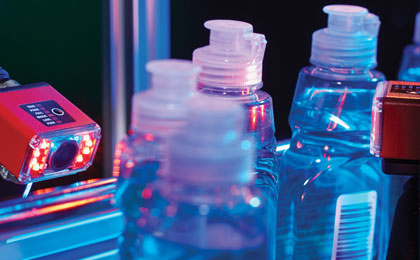How Barcodes On Labels And Packaging Support Flexibility In Consumer Packaged Goods Manufacturing
by Felix Klebe, Advanced Sensing Market Manager, Omron Automation Americas

As SKU proliferation becomes more widespread among consumer packaged goods (CPG) manufacturers competing for the loyalty of an increasingly choosy customer base, the need for flexible and robust manufacturing systems is taking centerstage. Today’s market puts a premium on flexibility, and the resulting product diversity is broadening the challenge of ensuring that product and packaging match up every time.
Manufacturers can overcome this challenge by making intelligent use of barcodes on labels and packaging materials to ensure that the right products are put in the right packages, both at the unit and case packaging levels. Overall, barcoding technologies and overall traceability solutions like the ones offered by Omron Automation Americas are becoming much more widespread in CPG labeling to help companies maintain high levels of accuracy while responding flexibly to changes in consumer demand.
A quick intro to the role of barcoding in product traceability
A barcode is basically a machine-readable representation of alphanumeric data that identifies and provides supplemental information about the product on which it’s labeled, printed or otherwise marked. The alphanumeric data is known as the barcode data string, while the barcode itself encapsulates this data in a specific pattern called a symbology. There are multiple symbologies in use today, and the choice of symbology depends on the space available for the barcode, the amount of data needing to be encoded within it, and in some cases, industry specifications such as GS1.
Throughout the various stages of a CPG production line, the manufacturing system instructs a barcode reader to scan codes on product labels or packaging materials to extract SKU data and other important product-related information. Prior to having a label applied to the product, the barcode is read and communicated to a production database to confirm that the correct label is going to be applied to the package based on the bill of materials (BOM) and the production order.
The system must also check barcode data printed on case labeling to confirm that the proper shipping carton is being used. This is another example of how the process of connecting a package identifier with the product that is expected based on the information in the manufacturing execution system (MES) database serves to minimize quality concerns and operational difficulties.
 Why barcoding works better than optical character verification
Why barcoding works better than optical character verification
Barcodes provide an extraordinarily efficient means of storing information within the cramped bounds of packaging. While optical character verification (OCV) can also be used to compare human-readable alphanumeric information on products and their packaging, this method tends to be slower, more complicated and more expensive, in particular because it requires advanced machine vision technology.
Encoding product identification data into a DataMatrix symbol that uses minimal space on the label constitutes a more efficient method of tracking packaging and performing quality checks. Today’s advanced barcode readers like Omron’s MicroHAWK series contain software that facilitates thorough verification and traceability, so it’s usually not necessary to use the advanced functionality that a machine vision system offers.
For example, a function known as string matching allows a specific set of logical requirements to be checked against information present in the barcode data string. If the encoded data needs to include a Global Trade Item Number (GTIN) followed by an 8-digit alphanumeric lot number and the manufacture date, then the match string logic can be used to confirm that the barcode contains all of this information in the correct format and sequence.
By taking advantage of the numerous processing functions available in today’s barcode readers, manufacturers can perform a wide range of manufacturing quality checks and traceability operations without needing to invest in a large amount of unnecessary machine vision functionality or having operators perform tedious and error-prone inspections. That said, if there’s a need to combine advanced quality inspections with product traceability, then a machine vision system can also take care of the barcode-reading tasks.
Making the most of barcoding to support mixed production
In the ideal mixed production environment, the enterprise level determines which type of product should be run at any given time and the machine level automatically adjusts to the right settings for that product. Since downtime can be expensive, it’s essential to find as many ways as possible to streamline the product changeover process. The right barcoding strategy can help with this.
The ability to store and quickly retrieve different match string settings is an important capability for a barcode reader used in a flexible manufacturing system. Manufacturers can take advantage of the so-called “configuration database” present within the memory of many barcode readers to quickly and accurately set up the reader for the particular product being run at a given time. A simple PLC-driven command can communicate to the database which configuration must be used based on the product that’s being run.
Perhaps the most obvious barcoding-related challenge for flexible manufacturing environments consists of the need for the reader to adjust quickly to different types of products that need to be produced on the same line throughout the day. This can require the system to change photometry settings based on a variety of object sizes, packaging styles and label designs to ensure reliable barcode reading at high speeds.
For applications where barcode position may differ with respect to each product’s orientation or the barcode’s location within the camera’s field of view, a higher-resolution smart camera or a series of cameras with daisy chain functionality may be required to ensure that all barcodes can be reliably read.
Today’s high-end barcode readers are easy to upgrade
For manufacturers implementing traceability for the first time, it can be difficult to decide whether to employ barcode readers or a machine vision solution that can take care of barcode data capture and various inspection tasks in one fell swoop. Fortunately, the most advanced barcode imagers on the market today are designed to transform into smart cameras with a simple software license upgrade that allows them to perform presence/absence detection, color verification, OCV and other tasks.
This close relationship between barcode imagers and smart cameras is making it more attractive for manufacturers to use compact 2D DataMatrix codes rather than 1D barcodes from the very get-go. DataMatrix codes can store large amounts of information while using minimal label or product real estate, and they’re easy for both barcode imagers and smart cameras to locate thanks to patterns within the symbol.
Since the essence of a flexible system is a strong ability to adapt to change while minimizing unnecessary capital investments, today’s barcode imagers provide an excellent solution. They can easily accommodate variations in product packaging, making it easy to use the same line to run a wide variety of products. If necessary, they can easily be upgraded to smart cameras in order to take full advantage of everything that machine vision has to offer.
 ---
---
By Felix Klebe, Advanced Sensing Market Manager, Omron Automation Americas
Omron Automation is an industrial automation partner that creates, sells and services fully integrated automation solutions that include sensing, control, safety, vision, motion, robotics and more. Established in 1933 and currently headed by President Yoshihito Yamada, Omron's 36,000 employees help businesses solve problems with creativity in more than 110 countries. Learn more at automation.omron.com.
---
Other Barcode articles you may enjoy:
